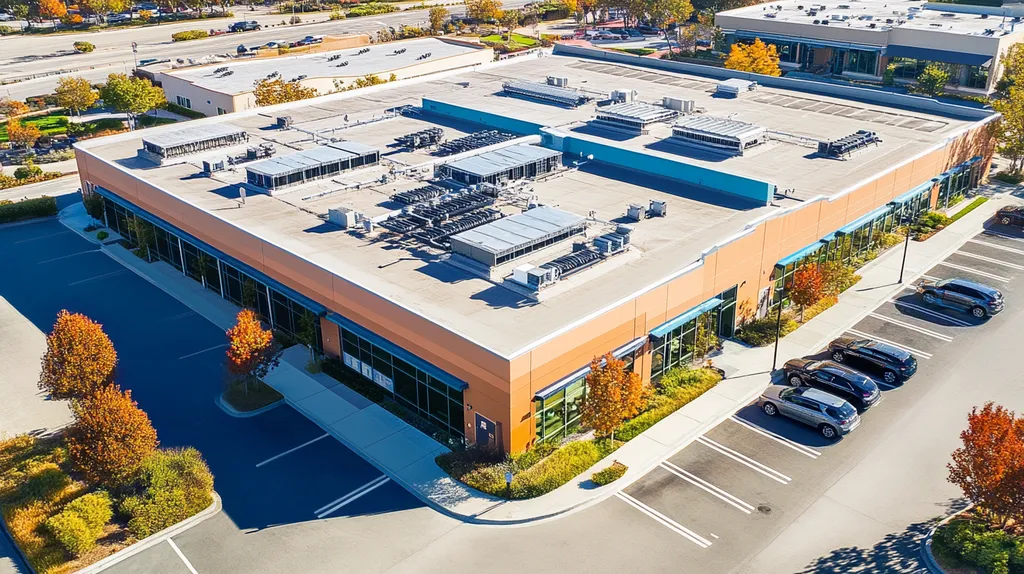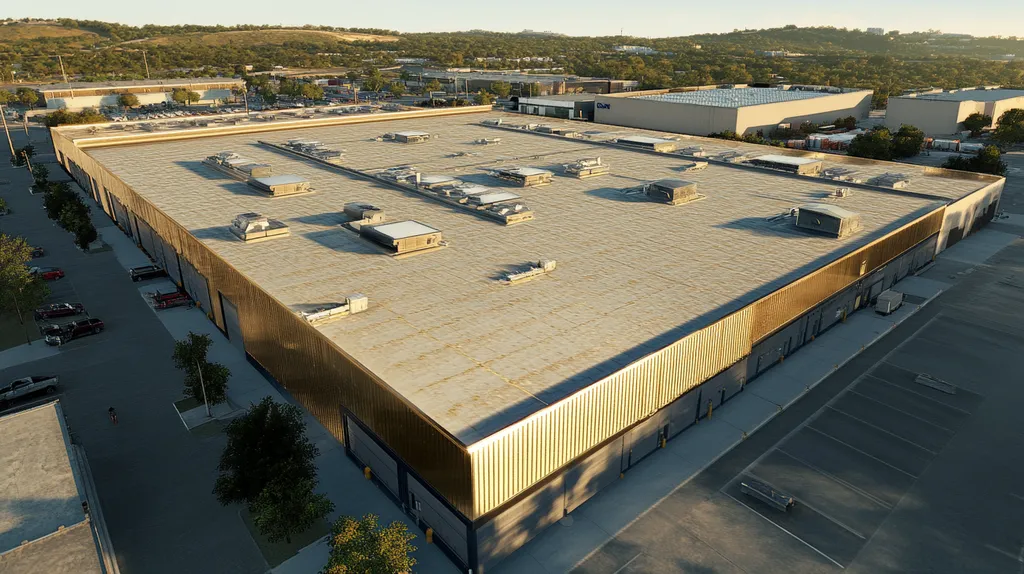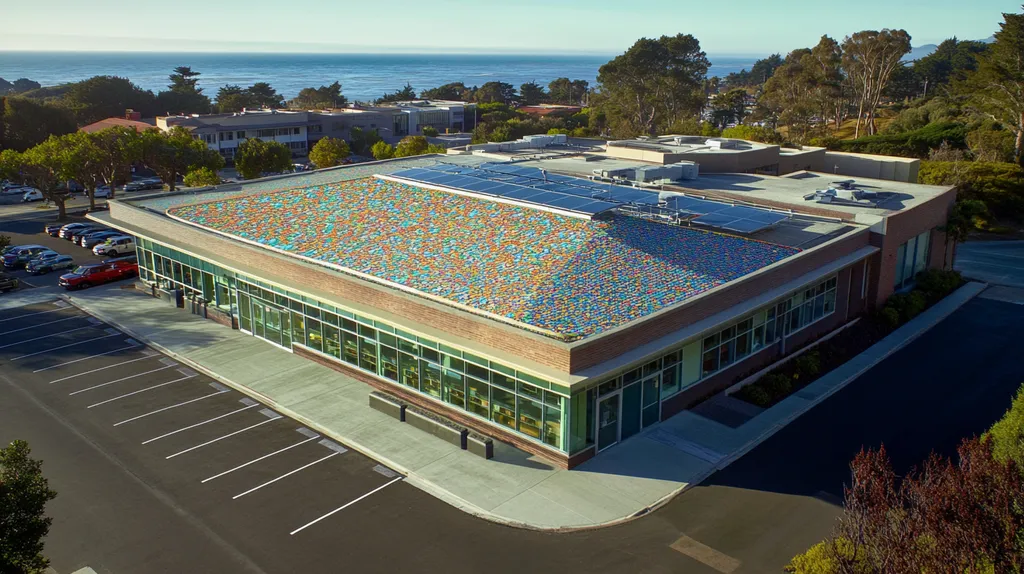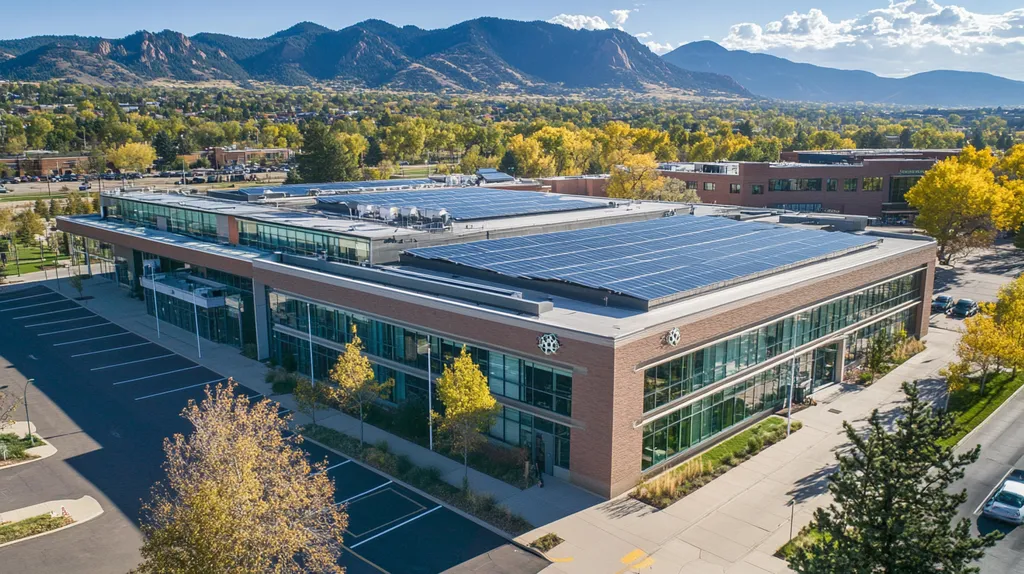In today’s industrial facilities, over 40% of catastrophic roof failures stem from inadequate safety systems and maintenance oversights, leading to millions in damages and significant operational disruptions annually.
A properly engineered industrial roofing system requires careful integration of structural components, weather barriers, and safety features – yet many facility managers struggle to navigate these complex requirements effectively.
This comprehensive guide examines the six critical elements of safe industrial roofing systems: performance factors, financial considerations, compliance requirements, risk management strategies, operational procedures, and long-term planning needs.
SECTION 1: PERFORMANCE FACTORS
The performance of an industrial roofing system is essential for maintaining safety, productivity, and financial stability. A roof that falls short in integrity can lead to severe consequences, including unsafe conditions and significant repair costs. In fact, a staggering 40% of roofing failures stem from improper installation or neglect during maintenance. This section delves into three critical performance factors: the structural integrity of the roof deck, insulation and energy efficiency, and the condition of the weatherproof membrane.
Structural Integrity of the Roof Deck
The roof deck serves as the foundation of a roofing system, meaning its structural integrity is paramount. Minor impairments can escalate into major issues, such as water leaks or even collapse, posing risks to the building’s occupants and operations.
Regular inspection of the roof deck is crucial. Facility managers can utilize moisture detection technology to uncover hidden problems that could compromise safety. Addressing these issues promptly not only prevents extensive repairs but also fosters a safer work environment.
The choice of materials significantly contributes to the roof deck’s strength. Opting for robust materials—like steel or reinforced concrete—over traditional wood can greatly improve durability and lifespan, bolstering the overall safety of the roofing system.
Key Action Items
Insulation and Energy Efficiency
Insulation plays a dual role—it not only influences energy efficiency but also supports the safety and longevity of the roofing system. Insufficient insulation can cause harmful heat accumulation, leading to premature deterioration of roofing materials.
Utilizing high-quality insulation, such as rigid or spray foam, can drastically improve energy efficiency by building a protective barrier against temperature fluctuations. Investing in solid insulation can yield energy savings of up to 30%, making it a wise choice for facility managers.
In addition, effective insulation aids in moisture control, as poor insulation can result in condensation build-up, creating an environment conducive to mold growth. Regular assessments should focus on the thermal resistance and moisture levels to ensure effectiveness.
Key Action Items
Weatherproof Membrane Condition
The weatherproof membrane protects the roofing system from external elements, serving as a frontline barrier against water and UV radiation. A compromised membrane can result in catastrophic damage and significant repair expenses.
Routine inspections are vital to ascertain the membrane’s integrity. Facility managers should look for signs of distress—such as cracks, blisters, or lifted seams—that could lead to leaks. Quick intervention can prevent small issues from spiraling into major repairs.
The type of membrane material also plays a critical role in durability and weather resistance. Options like Ethylene Propylene Diene Monomer (EPDM) and Thermoplastic Polyolefin (TPO) are popular for their strength and longevity, making them wise choices for industrial roofing.
Key Action Items
SECTION 2: FINANCIAL CONSIDERATIONS
When investing in an industrial roofing system, facility managers must navigate a landscape of financial intricacies that can significantly influence their budgets. Often, property owners may not account for hidden costs that can arise during the project, jeopardizing financial plans. Research suggests that unplanned repairs may exceed initial estimates by as much as 30%. Recognizing these financial elements is essential for making educated choices that ensure both the integrity of the roof and the financial well-being of the facility.
Cost of Materials and Installation
The initial expenditure for materials and installation typically represents the largest financial commitment in roofing projects. Options include TPO, EPDM, and metal roofing, each varying in price and performance. Selecting high-quality materials may involve a greater upfront cost but can significantly enhance the roof’s durability and longevity, ultimately offering better value over time.
The choice of contractor is just as crucial. Engaging experienced professionals can mitigate the risk of costly installation errors that could lead to leaks and structural issues down the line. A poorly executed installation may not only inflate repair costs but also shorten the lifespan of the roofing system.
Labor costs can vary according to local market conditions and the project’s complexity, making it essential to accurately assess these expenses. Aligning material choices with installation quality not only aids in immediate budgeting but also supports the roof’s long-term effectiveness.
Key Action Items
Maintenance and Repair Expenses
Regular maintenance is critical to preserving the financial health of a facility. Investing in a consistent maintenance program can decrease repair costs by as much as 60%, significantly extending the roof’s lifespan. Simple actions, such as routine inspections and swift repairs of minor leaks, can pay dividends down the line.
Neglecting maintenance can lead to severe issues, including structural damage and mold growth, necessitating expensive interventions. For example, a small leak allowed to worsen could escalate into a major repair, costing thousands in unforeseen expenses.
Moreover, a well-maintained roof contributes to a safer work environment and may even lead to lower insurance premiums for facilities that take proactive measures. Viewing maintenance as an investment rather than an expense enhances operational safety and longevity of the roofing system.
Key Action Items
Long-Term Cost Savings through Energy Efficiency
Investing in energy-efficient roofing systems can generate significant long-term savings. Reflective materials, such as cool roofs, can diminish cooling expenses by up to 30%, thus impacting the overall operational budget positively. By reflecting sunlight, these roofs help mitigate heat absorption and reduce air conditioning demands during hot seasons.
Furthermore, many energy-efficient roofs are eligible for rebates or tax incentives, which can further alleviate initial costs. Facilities that focus on energy-efficient choices often experience substantial long-term returns on their investments.
Modern materials typically offer better insulation properties, enhancing energy savings year-round. With energy costs trending upwards, these savings can accumulate, improving the facility’s overall profitability and financial health.
Key Action Items
SECTION 3: COMPLIANCE REQUIREMENTS
Adhering to roofing regulations is more than just ticking boxes—it’s crucial for ensuring workplace safety and extending the lifespan of roofing systems. With falls being the leading cause of fatalities in construction, as reported by OSHA, facility managers must prioritize compliance. This section emphasizes key compliance areas, including OSHA regulations, local building codes, and environmental considerations that protect both people and property.
OSHA Regulations for Roof Safety
OSHA enforces strict regulations targeting roof safety to prevent accidents. It’s essential for facility managers to implement fall protection systems, such as guardrails or personal fall arrest systems, especially where unprotected edges exist at heights of six feet or more. Recognizing and adhering to these regulations helps create a safe work environment.
Regular safety training sessions can ensure that all employees are fully aware of compliance requirements and can spot potential hazards. Establishing a safety-conscious culture not only safeguards workers but also shields facilities from costly fines related to non-compliance. Documenting compliance efforts through safety inspections and training records is vital, providing evidence of adherence to these essential guidelines.
Key Action Items
Local Building Codes and Standards
Local building codes set specific requirements for roofing systems that can vary significantly by region. These codes cover aspects like materials, methods, and safety protocols, tailored to the local environment. Facility managers must familiarize themselves with these local regulations to prevent delays or costly rework on roofing projects.
For example, in snowy areas, roofs may need to support additional weight, while areas prone to hurricanes often have stricter wind resistance requirements. Ignoring these local codes can lead to dire consequences, including structural failures that threaten both property and lives.
Early consultation with local building officials can pave the way for compliant and successful roofing projects, contributing positively to overall workplace safety and efficiency.
Key Action Items
Environmental and Health Compliance
Environmental and health compliance is an integral aspect of modern roofing practices. Facility managers must ensure adherence to regulations that restrict the use of hazardous materials, such as asbestos and lead, thus safeguarding the well-being of workers. Non-compliance can result in severe penalties and long-term health risks for employees.
In addition, sustainability considerations are becoming increasingly important in roofing projects. Opting for environmentally-friendly materials not only supports ecological goals but can also lead to cost savings and enhanced public image, as seen with the growing popularity of green roofs and reflective materials that lower energy costs.
Staying informed about current environmental regulations is essential for maintaining compliance and promoting sustainability. Regular audits can help uphold these standards while boosting overall facility productivity and safety.
Key Action Items
SECTION 4: RISK MANAGEMENT
Risk management is vital for the safety and longevity of industrial roofing systems. A staggering 50% of commercial roof failures arise from neglected maintenance and unidentified hazards. By proactively identifying potential risks, facility managers can safeguard not only their investments but also the well-being of everyone who occupies the building. This section focuses on hazard identification, preventing water damage, and minimizing environmental and structural risks.
Identifying Potential Hazards and Leaks
The first stride in effective risk management is recognizing potential hazards. Routine inspections are crucial for detecting problems such as cracks, loose membranes, or faulty flashing—issues that can ultimately lead to leaks and structural impairments.
Establishing a maintenance schedule ensures that risks are identified early on. Professional assessments conducted every six months can uncover issues before they escalate into expensive repairs. This proactive strategy not only saves money but also enhances the safety of building occupants.
It’s equally important to stay aware of changes in the building’s environment. Nearby construction activities or severe weather can introduce new risks. Facility managers should adjust their risk management tactics accordingly.
Employing advanced technology like infrared scans can significantly improve leak detection efforts. These tools identify issues that manual checks may overlook, making them a smart investment for long-term savings.
Key Action Items
Preventing Water Damage and Moisture Issues
Preventing water damage is essential to maintain a robust industrial roofing system. Water infiltration not only undermines the roof’s integrity but also leads to mold growth, presenting health risks to occupants. Adequate drainage systems are vital to prevent standing water on the roof.
Facility managers must ensure gutters and drains remain clear and functional. Regular cleaning prevents blockages that can result in water overflow. This straightforward maintenance task can avert costly water damage.
Selecting roofing materials known for their excellent waterproofing properties is equally vital. Options such as TPO, EPDM, and PVC demonstrate superior moisture resistance. Investing in the right roofing system significantly reduces future risks.
Installing moisture detection systems within the roofing assembly can be a proactive measure against leaks. These systems provide alerts about potential water intrusion before it escalates into further damage.
Key Action Items
Mitigating Environmental and Structural Risks
Understanding local environmental conditions is key to mitigating risks to industrial roofing systems. Factors like heavy snow accumulation, wind uplift, and extreme temperature fluctuations can put tremendous stress on roofing materials. Regular assessments help determine if the existing roof can handle local environmental challenges.
Facility managers should stay knowledgeable about local building codes and standards. Adhering to these regulations circumvents unnecessary legal and safety issues. Regular training for maintenance staff on these codes is also crucial.
Older buildings might require structural enhancements to improve load capacity and address environmental risks effectively. Such reinforcements can be a sound investment for extending the building’s lifespan.
Finally, creating a comprehensive emergency response plan is essential. This plan should outline steps for dealing with severe weather events or structural failures. Preparedness can minimize damage and enhance occupant safety in unforeseen situations.
Key Action Items
SECTION 5: OPERATIONAL PROCEDURES
Robust operational procedures are vital for the safety and longevity of industrial roofs. Regular inspections and maintenance are not merely best practices; they are essential to prevent costly repairs and safety hazards. Neglecting these crucial processes accounts for approximately 30% of roof failures, emphasizing the need for structured operational practices that prioritize inspections, effective training, and careful management of roof penetrations.
Regular Inspection and Maintenance Schedules
Establishing a regular inspection schedule is crucial for preserving the integrity of industrial roofing systems. Inspections should occur at least twice annually, focusing on high-risk areas such as seams, flashings, and drains. Following severe weather conditions, immediate evaluations are critical to identify any resulting damage.
Routine maintenance activities should encompass cleaning debris, checking for blockages, and ensuring all components are functioning properly. Keeping a comprehensive maintenance log is essential for tracking issues over time, enabling more informed decisions regarding necessary repairs or replacements.
The benefits of consistent inspections are profound. Facilities that adhere to regular inspection schedules typically enjoy longer roof lifespans, enhancing operational safety and significantly cutting replacement costs.
Key Action Items
Training for Maintenance and Inspection Personnel
The success of operational procedures relies heavily on the competence of personnel involved. Training maintenance and inspection staff should emphasize recognizing potential roofing issues and becoming familiar with the specific materials and systems in use. This empowers them to identify problems before they escalate.
Qualified personnel must be skilled in utilizing appropriate tools for inspections and adhering to safety protocols, thereby minimizing the risk of accidents during maintenance. Regular updates to training programs keep staff informed about the latest roofing technologies and best practices.
Furthermore, highlighting the significance of their role in the broader context of facility safety and compliance fosters a culture of accountability and diligence in maintenance efforts.
Key Action Items
Handling Roof Penetrations and Seals
Roof penetrations such as vents, drains, and HVAC units represent vulnerable points requiring careful oversight. Each penetration carries the potential to compromise the roof’s integrity if not properly sealed. Regular inspections should place significant emphasis on these areas, addressing any seal damage promptly to prevent leaks.
Utilizing high-quality sealants and flashing is essential for effective water intrusion prevention. Facility managers should collaborate with experienced contractors who understand best practices for installing and maintaining roof penetrations, ensuring compliance with industry standards.
Moreover, maintaining comprehensive records of all installations and repairs related to penetrations enables more effective long-term maintenance strategies. This documentation assists in identifying recurring issues and informs future repair decisions.
Key Action Items
SECTION 5: OPERATIONAL PROCEDURES
Effective operational procedures are essential for ensuring the safety and longevity of industrial roofs. Regular inspections and maintenance are not just good practices; they are vital in preventing costly repairs and safety risks. Statistics reveal that 30% of roof failures are linked to neglected operational processes. Therefore, facility managers must implement structured practices centered around consistent inspections, thorough training, and vigilant management of roof penetrations.
Regular Inspection and Maintenance Schedules
Establishing a robust inspection schedule is critical to maintaining an industrial roofing system’s integrity. Inspections should be conducted at least twice a year, focusing on vulnerable areas like seams, flashings, and drains. In addition, immediate evaluations after severe weather events are essential for identifying any resultant damage.
Routine maintenance tasks should encompass clearing debris, checking for blockages, and ensuring all roofing components are in good working order. Maintaining a detailed maintenance log is crucial for tracking issues over time, helping managers make informed decisions about necessary repairs or replacements.
The cumulative benefits of consistent inspections are substantial. Facilities adhering to rigorous inspection schedules typically enjoy extended roof lifespans, improved operational safety, and reduced replacement costs.
Key Action Items
Training for Maintenance and Inspection Personnel
The performance of any operational procedure heavily relies on the skill and knowledge of personnel involved. Training programs for maintenance and inspection staff should focus on identifying potential roofing issues and understanding the specific materials and systems in use. This proactive approach reduces the chance of overlooking critical problems.
Personnel must be proficient in utilizing the appropriate tools for inspections and familiar with safety protocols to mitigate risks during maintenance. Regular updates to training content ensure staff stays informed about advancements in roofing technologies and best practices.
Moreover, emphasizing the significance of their role in the broader context of facility safety and compliance with building codes encourages accountability and diligence in maintenance efforts.
Key Action Items
Handling Roof Penetrations and Seals
Roof penetrations like vents, drains, and HVAC units are critical areas needing careful oversight. Each penetration poses a risk to the roof’s integrity if not adequately sealed. Regular inspections should prioritize these zones, addressing any damage to seals without delay.
Using high-quality sealants and flashing is vital for preventing water intrusion. Facility managers are encouraged to collaborate with experienced contractors who are well-versed in the best practices for installing and maintaining roof penetrations, ensuring compliance with industry standards.
Moreover, keeping detailed records of all installations and repairs related to penetrations paves the way for more effective long-term maintenance strategies. This documentation aids in recognizing recurring issues and guides future repair actions.
Key Action Items
The Bottom Line
With 40% of catastrophic roof failures stemming from inadequate safety systems, the stakes for industrial facility managers have never been higher.
The evolution from traditional built-up roofing to today’s advanced synthetic systems demonstrates how far industrial roofing technology has progressed, yet the fundamental principles remain unchanged: thorough inspections, proper maintenance, and adherence to safety protocols.
The integration of structural integrity, weatherproofing, and energy efficiency continues to drive innovation in industrial roofing.
As regulations tighten and environmental concerns grow, facility managers must stay vigilant in maintaining comprehensive safety systems while adapting to emerging technologies and standards.
The future of industrial roofing lies in balancing these core safety requirements with sustainable practices and cost-effective solutions.
FREQUENTLY ASKED QUESTIONS
Q. What key performance factors affect my industrial roof?
A. The performance of your industrial roof hinges on three factors: structural integrity, insulation, and the weatherproof membrane condition. Each of these elements plays a crucial role in ensuring safety and efficiency. Regular inspection and maintenance can mitigate risks and extend the roof’s lifespan.
Q. How can I manage finances for a commercial roof project?
A. It’s essential to create a detailed budget that accounts for material costs, labor, and hidden expenses. Research options to find the best materials for your budget, and select experienced contractors to minimize the risk of costly mistakes that could affect your finances later.
Q. What compliance requirements should I consider for my industrial roof?
A. Compliance involves adhering to OSHA regulations, local building codes, and environmental standards. These regulations ensure workplace safety and structural integrity. Regular consultations with local building officials can help ensure that your roofing projects meet required standards and contribute to overall safety.
Q. How do I effectively manage risks for my industrial roofing system?
A. Start by conducting frequent inspections to identify potential hazards like leaks and structural issues. Regular maintenance practices can help mitigate risks and enhance the safety of your roofing system, ultimately protecting both your property and its occupants.
Q. What operational procedures should I implement for my commercial roof?
A. Implement regular inspection schedules and maintenance logs to track roofing conditions and repairs. Additionally, train personnel on safety protocols and the specifics of your roofing systems to ensure effective and safe operations, enhancing the roof’s longevity.
Q. How can I prolong the lifespan of my commercial roofing system?
A. Regular maintenance, timely repairs, and appropriate inspections are key strategies. Prioritize the health of vital components like insulation and membrane, and ensure compliance with safety regulations. Investing in quality materials upfront can also pay off significantly over time.
Q. What should I do about roof penetrations on my industrial roof?
A. Inspect all roof penetrations regularly for seal integrity and address any damage immediately. Using high-quality sealants is crucial for preventing water intrusion. Keeping detailed records of installations and repairs will also aid in long-term maintenance strategies.











